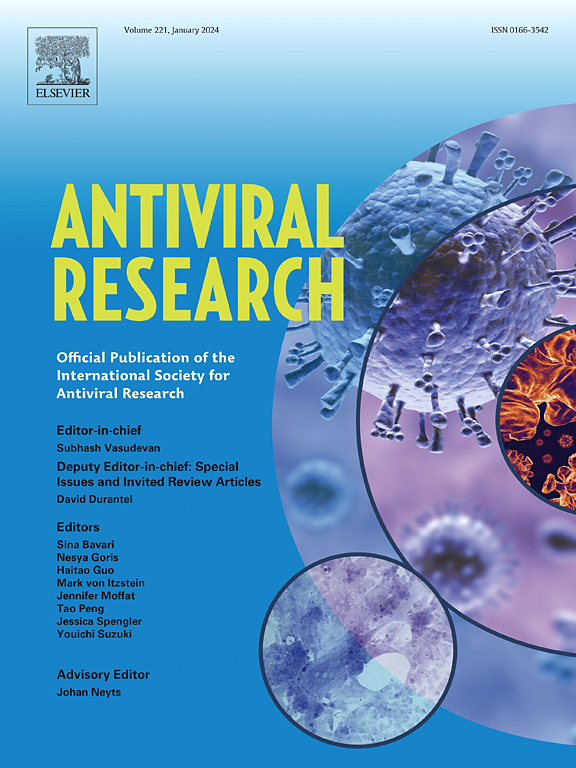Impact of the polymerase acidic protein E199K substitution in influenza A viruses on baloxavir susceptibility
IF 4
2区 医学
Q1 PHARMACOLOGY & PHARMACY
引用次数: 0
Abstract
Baloxavir marboxil, a cap-dependent endonuclease inhibitor, was approved in Japan in 2018 for the treatment and prophylaxis of influenza. Its active form, baloxavir acid, binds to the polymerase acidic (PA) protein endonuclease domain, inhibiting viral RNA cleavage. PA substitutions (e.g., E23K, I38T, E199G) have been associated with reduced susceptibility to baloxavir. During nationwide monitoring in Japan, we identified influenza A(H1N1)pdm09 and A(H3N2) viruses carrying a PA E199K substitution. Database analysis revealed that PA E199K is rare, detected in only 0.01 % of A(H1N1)pdm09 and A(H3N2) viruses. Because its impact on baloxavir susceptibility has not been reported, here, we characterized PA E199K mutant viruses in vitro. Phenotypic analysis showed a 5.0–5.2-fold increase in baloxavir EC50 values in PA E199K mutants, indicating reduced baloxavir susceptibility similar to PA E199G. However, replication efficiency of PA E199K mutants was significantly lower than wild-type viruses, suggesting impaired viral fitness. Unlike PA E199G, PA E199K introduces charge and steric changes that may further reduce replication capacity. While PA E199G mutants have led to a community cluster, PA E199K has only been detected sporadically, likely due to its greater impairment of viral replication. The PA E199K mutants were susceptible to neuraminidase inhibitors. Given the increasing global use of baloxavir, continuous monitoring of resistance-associated substitutions is essential for public health and clinical management.
甲型流感病毒聚合酶酸性蛋白E199K取代对巴洛沙韦敏感性的影响
Baloxavir marboxil是一种帽依赖性核酸内切酶抑制剂,于2018年在日本被批准用于治疗和预防流感。它的活性形式,巴洛韦酸,结合聚合酶酸性(PA)蛋白内切酶结构域,抑制病毒RNA切割。PA取代(如E23K, I38T, E199G)与对巴洛昔韦的易感性降低有关。在日本全国监测期间,我们发现甲型H1N1流感pdm09和甲型H3N2病毒携带PA E199K替代。数据库分析显示pae199k是罕见的,仅在甲型H1N1 pdm09和甲型H3N2病毒中检测到0.01%。由于其对巴洛韦易感性的影响尚未报道,因此,我们在体外鉴定了PA E199K突变病毒。表型分析显示,PA E199K突变体巴洛韦EC50值增加5.0 - 5.2倍,表明与PA E199G相似,巴洛韦敏感性降低。然而,pae199k突变体的复制效率明显低于野生型病毒,表明病毒适应性受损。与pae199g不同,pae199k引入电荷和空间变化,可能进一步降低复制能力。虽然pae199g突变体导致了社区集群,但pae199k仅被偶尔检测到,可能是由于其对病毒复制的损害更大。PA E199K突变体对神经氨酸酶抑制剂敏感。鉴于巴洛昔韦在全球的使用日益增加,持续监测与耐药性相关的替代药物对于公共卫生和临床管理至关重要。
本文章由计算机程序翻译,如有差异,请以英文原文为准。
求助全文
约1分钟内获得全文
求助全文
来源期刊

Antiviral research
医学-病毒学
CiteScore
17.10
自引率
3.90%
发文量
157
审稿时长
34 days
期刊介绍:
Antiviral Research is a journal that focuses on various aspects of controlling viral infections in both humans and animals. It is a platform for publishing research reports, short communications, review articles, and commentaries. The journal covers a wide range of topics including antiviral drugs, antibodies, and host-response modifiers. These topics encompass their synthesis, in vitro and in vivo testing, as well as mechanisms of action. Additionally, the journal also publishes studies on the development of new or improved vaccines against viral infections in humans. It delves into assessing the safety of drugs and vaccines, tracking the evolution of drug or vaccine-resistant viruses, and developing effective countermeasures. Another area of interest includes the identification and validation of new drug targets. The journal further explores laboratory animal models of viral diseases, investigates the pathogenesis of viral diseases, and examines the mechanisms by which viruses avoid host immune responses.
 求助内容:
求助内容: 应助结果提醒方式:
应助结果提醒方式:


